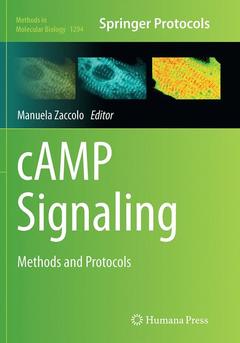cAMP Signaling, Softcover reprint of the original 1st ed. 2015 Methods and Protocols Methods in Molecular Biology Series, Vol. 1294

This detailed volume encompasses new technological developments that specifically address questions related to adenosine 3?,5?-monophosphate (cAMP) compartmentalization, that probe relevant protein-protein interactions, that increase the spatial and temporal resolution of cAMP signal detection, and that can facilitate integration of the mounting complexity of the information that is becoming available on this signaling system. cAMP, the prototypical intracellular second messenger, regulates a large variety of cellular functions and biological processes, including gene transcription, cell metabolism, proliferation, development, as well as more specialized functions depending on the cell type, so the realization of its extremely complex spatial organization and local regulation is providing novel mechanistic insight into cell physiology and is producing a novel framework for the identification of disease mechanisms. Written in the highly successful Methods in Molecular Biology series format, chapters include introduction to their respective topics, lists of the necessary materials and reagents, step-by-step, readily reproducible laboratory protocols, and tips on troubleshooting and avoiding known pitfalls.
Practical and authoritative, cAMP Signaling: Methods and Protocols serves as a vital resource for researchers working in this expanding, complex field.
1. Simultaneous Assessment of cAMP Signaling Events in Different Cellular Compartments Using FRET-Based Reporters
Alex Burdyga and Konstantinos Lefkimmiatis
2. Recording Intracellular cAMP Levels with EPAC-Based FRET Sensors by Fluorescence Lifetime Imaging
Marcel Raspe, Jeffrey Klarenbeek, and Kees Jalink
3. A Novel Approach Combining Real-Time Imaging and the Patch-Clamp Technique to Calibrate FRET-Based Reporters for cAMP in Their Cellular Microenvironment
Andreas Koschinski and Manuela Zaccolo
4. Structure-Based, In Silico Approaches for the Development of Novel cAMP FRET Reporters
Matías Machado and Sergio Pantano
5. Automated Image Analysis of FRET Signals for Subcellular cAMP Quantification
Silas J. Leavesley, Arie Nakhmani, Yi Gao, and Thomas C. Rich
6. Channel-Based Reporters for cAMP Detection
Thomas C. Rich, Wenkuan Xin, Silas J. Leavesley, and Mark Taylor
7. Imaging Sub-Plasma Membrane cAMP Dynamics with Fluorescent Translocation Reporters
Anders Tengholm and Olof Idevall-Hagren
8. Adenoviral Transduction of FRET-Based Biosensors for cAMP in Primary Adult Mouse Cardiomyocytes
Oliver Lomas, Marcella Brescia, Ricardo Carnicer, Stefania Monterisi, Nicoletta Surdo, and Manuela Zaccolo
9. Generation of Transgenic Mice Expressing FRET Biosensors
Daniela Hübscher and Viacheslav O. Nikolaev
10. Photoactivatable Adenylyl Cyclase (PACs) as a Tool to Study cAMP Signaling In Vivo: An Overview
Marina Efetova and Martin Schwärzel
11. Selective Disruption of the AKAP Signaling Complexes
Eileen J. Kennedy and John D. Scott
12. Screening for Small Molecule Disruptors of AKAP-PKA Interactions
Carolin Schächterle, Frank Christian, João Miguel Parente Fernandes, Walter Rosenthal, and Enno Klussmann
13. Structure-Based Bacteriophage Screening for AKAP-Selective PKA Regulatory Subunit Variants
Ryan Walker-Gray and Matthew G. Gold
14. A Yeast-Based High-Throughput Screen for Modulators of Phosphodiesterase Activity
Ana Santos de Medeiros and Charles S. Hoffman
15. Separation of PKA and PKG Signaling Nodes by Chemical Proteomics
Eleonora Corradini, Albert J.R. Heck, and Arjen Scholten
16. Development of Computational Models of cAMP Signaling
Susana R. Neves-Zaph and Roy S. Song
Includes cutting-edge methods and protocols on cAMP signaling
Provides step-by-step detail essential for reproducible results
Contains key notes and implementation advice from experts
Date de parution : 10-2016
Ouvrage de 222 p.
17.8x25.4 cm
Ouvrage de 222 p.
17.8x25.4 cm



